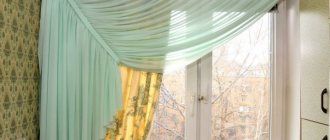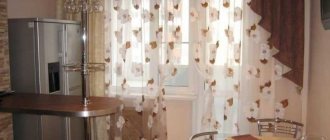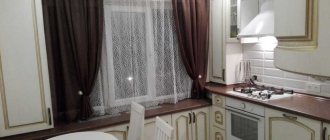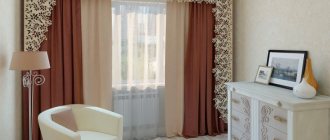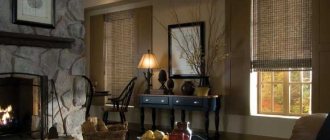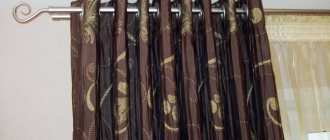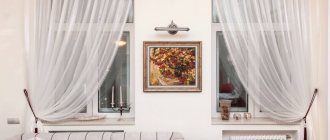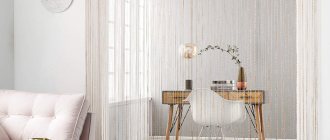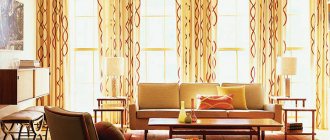Curtains on one side can visually change the atmosphere. They decorate the kitchen, give it a unique style, do not interfere with cooking, and bring freshness and comfort. Traditional curtains, moved to the right or left, are not able to change the interior in such a way. To get a harmonious result, you need to correctly combine furniture and textiles, and also take into account some nuances.
Advantages and disadvantages of asymmetrical curtains
This window design has several advantages, including:
- Easy to use - they open and close easily. The canvas is gathered into soft folds and fixed with a clamp;
- Safe to use near heating devices. When the stove is located next to each other, the curtain is assembled from the opposite side;
- Protection against accidental fire. Classic curtains can swell over a burning stove, causing the textiles to ignite. This will not happen with curtains assembled on one side, since they are well fixed;
- Less fabric consumption for sewing, which allows you to choose a more expensive model;
- Curtains allow more air to pass through, provide spaciousness and free space, which visually enlarges the kitchen;
- A large selection of different designs, allowing you to choose options for any style.
Green curtain with tieback
The disadvantages are mainly related to the characteristics of the curtains:
- A non-standard style is not suitable for interiors with many flashy accents, since the kitchen space will look overloaded and very colorful;
- Curtains do not provide the necessary darkening, which is not suitable for kitchens located on the south side;
- For classic interiors, this style is also not always appropriate, since this style is characterized by clear lines and symmetry.
One-sided curtain in combination with a lambrequin
Types of premises where they are used
Curtains with asymmetrical details and cut are used:
- In offices, agencies, studios, offices - models of bright contrasting colors made of practical fabrics.
- In cafes, restaurants, hotels , classic draperies combined with asymmetrical lambrequins and draperies are especially popular. The fabrics used are dense, flowing, glossy fabrics.
- In stores of different directions there are shortened versions of bias-cut curtains in calm shades.
Curtains for the bedroom - new 2016:
(0) comments
Types of curtains on one side
There are several types of asymmetrical curtains that can be used to decorate a kitchen window:
- Classic. This is a traditional silk, satin or synthetic fabric of a wide rectangular shape with different lengths, gathered on one side with a grab or clamp. Massive curtains together with weightless tulle will emphasize the elegance of the interior. If the space is small, then instead of massive curtains, hang models knitted from thin threads. This option is used in many directions - both in classics and in minimalism;
- With lambrequin. They look beautiful in Provence and shabby chic styles. More often there are models made from natural textiles of linen, cotton, chintz with a medium-sized floral print and simple ornament. Often textiles are wrapped around the cornice, leaving hanging edges. Sometimes they are fixed with grabs. Curtains with a lambrequin are not appropriate for kitchens with low ceilings. Curtains on one side with a lambrequin require additions, for example, in the form of tulle or blinds, since a cornice simply wrapped in fabric does not look very aesthetically pleasing;
- Combined. Here curtains of different styles, textures, colors, and lengths are combined. With the right combination, you get an original drapery that emphasizes the interior and features of the kitchen. The density and transparency of the canvas varies and is selected individually for each design.
Color palette and designs: do not create dissonance
Don’t try to collect all the beautiful textiles that you have stored for the room into one ensemble on the windows. Instead of an “interior symphony” you get an “amateur artistic performance”. Here are some tips on how to maintain a sense of proportion when decorating a window with your own hands.
If the window composition as a whole is symmetrical, and there is only one “wrong” element in it, it is preferable to highlight it with color, or choose a darker tone.
It is advisable to leave two curtains of different lengths the same color. But in combination with identical curtains and an asymmetrical curtain, the color of the former can be contrasting.
In multi-layered ensembles it is better not to be colorful. If they consist entirely of transparent fabrics, let them all be plain. Choose shades based on how they look when placed on top of each other. If the composition is completed by curtains or a lambrequin, they can be with a pattern, but the tulle part remains monochromatic.
Avoid combining two fabrics with different patterns. Such combinations are only possible for a professional.
How to hang asymmetrical curtains in the kitchen
To properly hang one-sided curtains, they are fixed to the cornice with loops or rubberized eyelets. Ordinary rings are not used here, since they will move at the slightest touch or blow of wind.
Red one-sided tulle on eyelets
The free edge of the curtain is secured with tiebacks or magnetic holders. To create harmony in the interior, you need to remember the short side. Often, tulle is used for this, which is made slightly shorter than the main curtain.
Single sided layered curtains
When decorating a window with a curtain on one side, it is better not to use heavy textured fabrics with lush ruffles, as they visually weigh down the entire composition and make it too catchy.
Light organza curtain
Here are the most common ways to hang asymmetrical curtains:
- Various lengths of curtains. It looks beautiful in kitchens with a balcony exit;
- Drapery with one wide curtain, fixed with an original tie on one side;
- Combination with a lambrequin that follows the asymmetry line of the curtains;
- Diagonal cut. On one side, the curtains mask a small part of the window, and on the other they reach the window sill or floor;
- Multi-layer curtains, main fabric and lambrequin. Each element of the composition with its own parameters, length and style;
- Symmetrical asymmetry. Suitable for corner windows, arches and multiple windows. One is decorated with a curtain on one side, and the second is its mirror reflection;
- A game of contrasts. The curtains have an identical style, but different colors. A window composition made of single-color canvases in addition to printed curtains looks beautiful.
Curtains on one side are a design solution that transforms any interior and becomes its highlight. Therefore, there is no need to use large quantities of additional decor.
Fabrics
When using asymmetry in only one part of a set of curtains, dense expensive materials look especially advantageous:
- Tapestry.
- Velours.
- Velvet.
- Jacquard.
- Brocade.
- Fabrics with gold thread.
Asymmetrical curtains perfectly hide architectural imperfections and add dynamism and originality to the design of the premises.
For asymmetrical curtains on small windows, light transparent fabrics are used:
- Organza.
- Tulle
- Chiffon.
- Batiste.
- Net.
- Veil.
Decor and accessories options
Various decorations will help emphasize the originality of the interior. The main ones are fabric tiebacks fixed to the wall. They can become the main accent in the interior. Curtain tiebacks are designed in different ways:
- Decorative textile belt attached to a hook on the wall. It can remain unnoticed or, conversely, be an additional window decoration;
- A twisted cord that is tied in a bow or intertwined. It can be a couple of tones brighter than the curtain;
- A chain that matches beautifully with curtains hanging on a metal curtain rod. It shouldn't be very thick. A thin chain is even used to pick up tulle;
- Buttons. They come in an original look and the same or different shade from the curtains;
- Flower pot. A rare, unusual technique to pick up a curtain. The flowerpot is placed on the desired side of the window, the edge of the curtain is folded and attached to the flowerpot stand with a loop sewn to the textile.
We sew asymmetrical window decorations with our own hands
Let's try to sew the flirty model shown in the photo. This is one of the options suitable for a kitchen with a window in the corner of the wall.
The bottom fabric is very easy to sew. Determine the length as desired, take approximately double the width (for assembly). The bottom cut is finished with a tight zigzag stitch or a roller stitch, if your machine has one. A curtain tape is attached to the top edge.
For the most draped curtain, you will also need at least two widths of fabric (if you want a more fluffy gather, take an even wider fabric). The length is also arbitrary (in the photo - up to the window sill).
We process the upper and lower cuts in the same way as the first option. Now we begin to create the “highlight” - the oblique drapery. It is obtained by tightening a cord stretched along an oblique line.
To determine its location, you can hang the curtain on the curtain rod and secure it with a rope or tape in the right place. Mark the beginning and end points of this line from the wrong side, then lay out the canvas and connect these points from the wrong side with chalk or soap.
The drawstring for the cord itself can be designed in different ways:
- Sew bias tape along the line and thread the rope through it. Connect the ends and secure them to the outer hook, pulling them to the desired amount.
- Instead of trim, you can sew the same curtain tape - the gathering will be uniform.
- Thread an elastic band into the drawstring, which is used in belts to regulate volume - it has holes for buttons. By sewing a button on the inside of the top edge of the gather, you can also change the size of the gather.
Sewing such a curtain with your own hands is not a difficult task. All that remains is to iron the product.
Asymmetrical curtains are a difficult element of the interior. But, chosen correctly, they can change it beyond recognition.
What material is suitable for the kitchen
Kitchen specifications impose certain requirements on the material of curtains - they should not quickly become dirty and wrinkled, absorb odors from cooking, fade in the sun, and withstand frequent washing, changes in temperature and humidity. Basically, kitchen curtains are made from the following fabrics:
- Taffeta. Usually it is woven from silk, but for the kitchen it is better to take cotton-synthetic textiles. It is resistant to various stains, dries quickly and supports wet cleaning;
- Kisey or thread curtains. This type consists of many thin ropes. Excellent for kitchens, since stains and dirt are not noticeable on such curtains;
- Natural materials (cotton, linen, silk). They resist fire, do not wrinkle, look elegant and simple on the window;
- Viscose and polyester. These are synthetic materials that have increased strength and can easily cope with difficult kitchen conditions.
The transparency of curtains is of great importance. There are three types in total:
- Transparent material. It transmits approximately 70% of light and retains almost no light. There is always a lot of daylight in the kitchen, cooking and cleaning will be comfortable. But such transparent curtains are only suitable for kitchens located on the upper floors, as they do not provide privacy. These include thread curtains and tulle.
Single Sided Lace Sheer Tulle
- Scattering. These are curtains in the kitchen that let in maximum natural light, but scatter it throughout the space. Through them the room is hidden from prying eyes, but fully illuminated. These are, for example, satin curtains.
- Opaque. Its characteristics are similar to blackout, that is, the density blocks light, preventing it from penetrating into the kitchen. These are, for example, velvet curtains.
Color selection
The color of curtains in the kitchen depends on its style, dimensions and the desire of the owner. Since the curtains are assembled from one side, the design will look more massive from there. To get a harmonious window composition, you need to choose the right color that does not stand out from the design and does not irritate the eyes.
White and brown curtains in the kitchen
- All pastel colors - both warm and cold (beige, soft pink, powdery, milky). These are neutral tones that do not visually squeeze the interior and look unobtrusive and neat;
Long dusty pink curtains
- White is a basic color that suits any style. It does not strain the eye and creates the effect of freedom. White curtains visually look smaller. White also reflects light well, which means the kitchen will be brighter. But it is worth considering that such curtains will quickly get dirty in a kitchen environment. It is better to take its shades - milky, baked milk, beige;
- Grey. A color that belongs to the neutral palette. It can also be used in almost all styles;
- Green and its palette are associated with nature and do not put pressure on people. They are found in classicism, minimalism or eco;
When choosing a pattern or patterns for one-sided curtains, only one thing is taken into account - their compliance with the kitchen design. The most popular prints are polka dots, checks, stripes, flowers. The contrast of close tones looks beautiful. If the kitchen has wallpaper with a pattern, then it is better to choose plain curtains so as not to overload the interior. Also, do not choose too bright designs, which can ruin the relaxing atmosphere.
Checkered curtains with eyelets combined with original tulle
If you don’t want to focus on the window, then it’s better to hang curtains to match the furniture, without choosing models with ruffles, draperies and catchy patterns. To prevent the curtains from blending into the walls, the canvases are chosen several shades lighter or darker. Neutral models are appropriate for a flashy setting, and a restrained interior will be transformed by a colorful pattern on the curtains.
Light curtains to match the set
In small kitchens, curtains made of light, transparent materials are appropriate, which visually expand the space and add air. To make the decor look neat, choose large patterns. Also, dark colors are not suitable for small kitchens, otherwise the decor will turn out gloomy and cramped. A one-sided shortened curtain looks easy in the interior, without weighing down or overloading the decor in the kitchen.
Transparent curtains in a small kitchen
Not recommended places
Naturally, asymmetrical curtains are not appropriate everywhere. It is important to know about places where they are not recommended so as not to make mistakes. So:
- Small rooms do not accept irregular fabric lines. A non-symmetrical curtain for a small room will look out of place, reducing the already un-royal size of the window. For them, traditional fabrics are always considered - multi-layer curtains and floor-length tulle.
- Children's rooms. Playing with fabrics is more appropriate in common rooms. Asymmetrical curtains for children's bedrooms will be overloaded; for children's eyes during games, this is contraindicated.
- Rest rooms. Sleeping curtains for irregularly shaped windows still remain a traditional shape, since asymmetry involves leaving the edge of the window open, which is inappropriate for sleeping. And heavy fabrics, selected specifically for the bedroom, should fall to the floor, without forming diagonals.
- Rooms with a lot of furniture and accessories also do not accept overload with asymmetrical textiles - everything will merge into one large woven spot.
- Cabinets do not welcome multi-layering. Ruffles, lambrequins and other things that make the room a kind of alcove. In offices, curtains with asymmetrical ties are not used - this is bad manners.
- In interiors of new styles - high-tech or minimalism, canvases with lambrequins or asymmetrical curtains for the kitchen, bedroom, living room will become out of the general concept. For such a vision, only multi-layers of light curtains and blinds are possible.
The correct design of window decoration with asymmetrical canvases must be verified at the stage of purchasing such canvases.
Curtains should be one with the room
It is also worth considering working with your own hands if you have the skill to operate a sewing machine. A variety of curtain shapes - angular, with lapels, puffs - will transform a simple window and highlight non-standard ones.
The best posts
- How to correctly calculate the material for a gazebo for a summer residence
- A simple homemade folding picnic table
- Automatic curtains for windows and cornices: 5 main advantages
- How to protect your apartment from the cold
- How to join drywall in corners and the process of building a decorative niche
- 50 DIY gift ideas for February 23 (35 photos)
- What is plaster grinding? Technology of work execution
- Tips for choosing heat-resistant adhesive for fireplace surrounds
